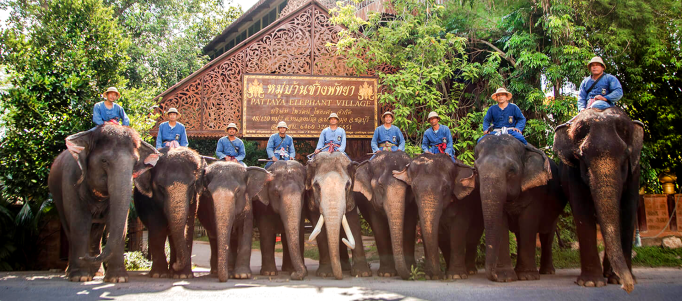No circus shows, only a close-up look at the interesting life of an elephant

Besides the beaches and night life, there are other things to enjoy in Pattaya. Tucked a little away from the city are some paddy fields and forest areas to explore, and there’s no better way to do it than on an elephant’s back.
An elephant ride is a unique experience. Centuries ago, it was theexclusive royal mode of transport. If you care a little of Thai History, King Rhamkhaeng the Great rode on an elephant to do battle against Khun Sam Chon, the ruler of the Chod City. And King Jak Kra Pad the Great fought against Prince Prae on his elephant. He too won the battle.

Many other stories show how Thais look up to elephants as more than mere animals. In fact, elephants are well spoken of in their arts, literature and social life.
In Pattaya, the place to see elephants up close is, of course, the Elephant Village. The village was founded in 1973 as a sanctuary for former working elephants retired for injury, ill health or old age. With their condition, theyare not likely to survive if returned to the wild.

A private company run on a nonprofit basis, the Elephant Village was founded by Mr. Phairat Chaiyakham, who remains the managing director till today. After operating costs had been deducted, all proceeds from its activitiesgo into the upkeep of the animals. The village doesn’t receive any support from the government or any private group.
From childhood he has fascinated by elephants. “When I was a boy, I used to wonder many things about elephants, like how are they fed and how much food do they eat everyday.”
“Now I know the answer,” he quips with a smile, having run the village hands on during the last four decades. “And it costs a lot to provide them food and medicine.”
The village has fifty elephants and employs about a hundred people to look after them. It has three elephant shows daily. About a thousand people visit Elephant Village every day.

Mr. Phairat personally designed these shows, which typically depicts the animals’ daily routine, starting withtheir bathing. “If you want a show that you see in a circus, you won’t find it here,”he says. In fact, show routines one finds in other elephant shows, like a pachyderm shooting a basketball into a ring, aren’t done here.
“We consider our animals like members of our family. So we treat them with respect,” he says.
The Elephant Village is located at 48/120, Moo 7, Tambon Nong Prue, Pattaya. Call 038-249818, 038-249853, 038-734470, 081-8114249, 086-1488185 or 081-2957231 for inquiries. You can also send email to info@elephant-village-pattaya.com or visit its website at http://www.elephant-village-pattaya.com.




 For those who don’t want to wait, there’s always fried stuffed crabs (poo ja), which is basically crab meat, pork, eggs and spices cooked in the shell. Try also mud crabs cooked in coconut milk and deep-fried crab skulls dish (kanchiang poo neung).
For those who don’t want to wait, there’s always fried stuffed crabs (poo ja), which is basically crab meat, pork, eggs and spices cooked in the shell. Try also mud crabs cooked in coconut milk and deep-fried crab skulls dish (kanchiang poo neung).




